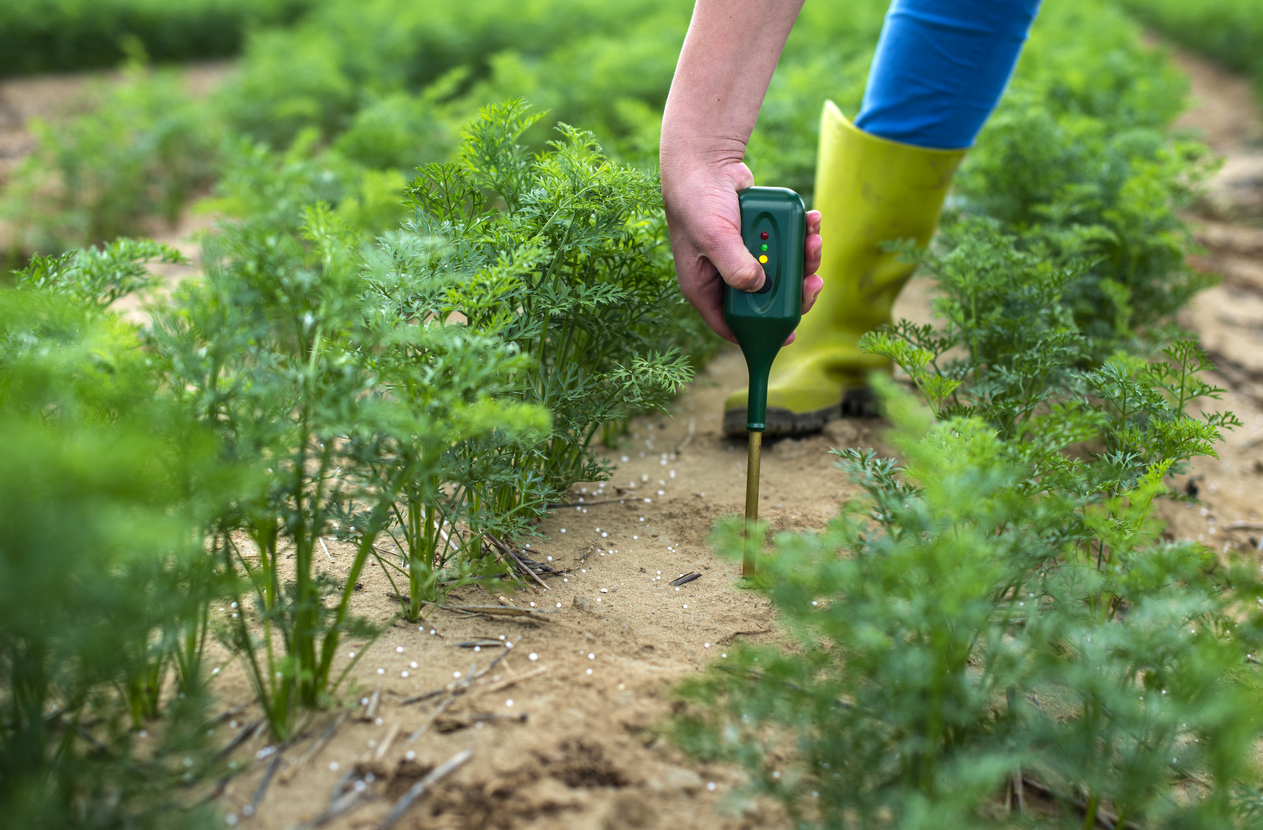

We may earn revenue from the products available on this page and participate in affiliate programs. Learn More ›
The first step to growing a beautiful, healthy garden is to improve the garden soil. Fertilizer provides necessary plant food elements, including nitrogen, phosphorus, potassium, and others. Gardeners also can improve the soil structure and organic content when they use compost or mulch. These improve the soil’s ability to handle water and provide a nutrient buffer, while allowing plant roots to penetrate deeply, reducing the negative impacts associated with runoff.
Less commonly understood is the role of soil pH, and how to use garden lime to adjust it. What is garden lime used for? When soil is too acidic, some plant food elements are chemically locked up, or unavailable for plants to take up, even though they are present in sufficient amounts. This leads to sick plants. Adding fertilizer might appear to help, but it is a costly, temporary solution that risks polluting groundwater and streams with excessive nutrients. The better, more efficient solution is to apply inexpensive garden lime to unlock existing plant food in the soil. Here’s how to do it.
RELATED: How to Cultivate the Perfect Soil for Your Vegetable Garden
What is garden lime?

If you look for “lime” at your local home improvement store or online, you might not get what you need. Hydrated lime, or calcium hydroxide, is available for use in masonry but is not great for gardening. Similarly, quick lime, or calcium oxide, is not for gardening. Instead, gardening lime will be labeled “garden lime,” “agricultural lime,” or “dolomitic lime.” These products are made of pulverized, natural limestone or dolomite rock.
Regular garden lime uses limestone, which is high in calcium carbonate, to adjust the soil pH. Calcium also is a necessary plant nutrient that strengthens cell walls and prevents blossom end rot in tomatoes, peppers, and other garden produce. Garden lime is available either as pellets or powder. The coarse pellets like this highly rated option available at Amazon work to reduce soil acidity somewhat slower than the fine powder. Choose pellets for regular maintenance and powder like this option available at Ace Hardware for a quick reaction.
Dolomitic lime is high in calcium carbonate too, plus it adds significant quantities of magnesium, another vital plant nutrient. Magnesium is the core of the chlorophyll molecule, which enables plants to perform photosynthesis. Dolomitic lime is typically packed in a granular or pellet-like form.
RELATED: All You Need to Know About Loamy Soil
Test your soil to determine whether it needs garden lime.

Gardening experts agree that the best way to know what the soil needs is to test it. Submit a soil sample to your Cooperative Extension Service lab to learn how you can improve your garden’s soil and whether lime might help. Or choose an over-the-counter soil pH test kit to learn if your soil is too acidic and you need lime for the garden.
A lab test will provide the most accurate and comprehensive results and guidance for long-term soil improvement. An over-the-counter kit like this one available at Amazon—selected “best overall” in our researched guide to the best soil test kits—is good for those with a short timeline, and for regular monitoring between annual or biennial lab tests.
For most lawn grasses and vegetable gardens, a pH reading between 6.0 and 7.0 is good. If the test results come back below 6, an application of lime can help raise the pH (reduce the acidity) to the ideal range. Exactly how much lime you need to apply to gain the desired results depends on the type of lime and the soil makeup. As with any soil amendments, follow the soil test results and recommendations carefully.
Err on the side of caution when amending soil with garden lime.

Excessive garden lime can raise the soil pH out of balance to the opposite end of the spectrum. Instead of being too acidic, soil can become too alkaline. When this happens, plants will not be able to take up certain necessary elements even if they are sufficiently present in the soil, and the plants will suffer nutrient deficiencies. Also, too much calcium in the soil blocks magnesium uptake.
Another risk of adding too much garden lime too quickly is that it dries out the soil. The same chemical reaction that adjusts the pH also causes water to evaporate from the soil more quickly. This is especially noticeable when working with garden lime powder, but it can happen with pellet lime as well. Avoid applying lime during hot or dry weather.
The best way to apply garden lime is to spread it evenly over the ground, then cultivate it into the soil. For all but the smallest garden spaces, use a garden spreader to get an even application. For lawns, aerating first ensures that the lime will work its way into the lower soil levels. On garden beds, use a hard rake or rototiller to gently cultivate the top 3 or 4 inches of soil after liming.
RELATED: Know the Types of Soil
Fall is the best time to add garden lime.

For many gardeners, fall is the ideal time to apply garden lime. Cool fall temperatures, combined with upcoming winter moisture, allow pelletized lime to do its work without the danger of drying out the soil or stressing out plants. By the time spring gardening season arrives, the soil will provide an ideal growing environment.
However, if you miss the autumn window and the garden needs lime treatment, spring is another fine time to add lime. Apply it as soon as is practical, and be sure to closely monitor soil moisture after planting.
